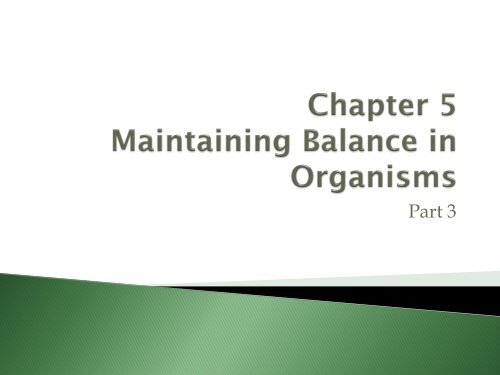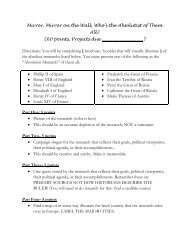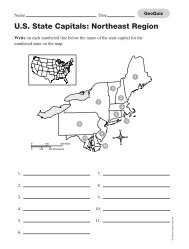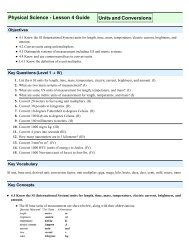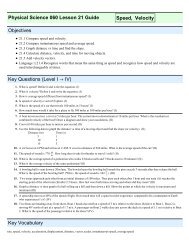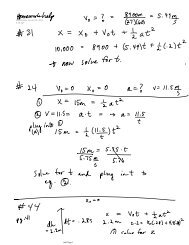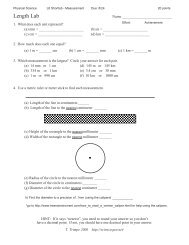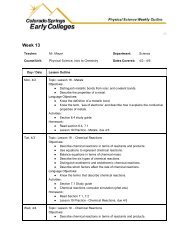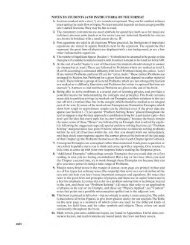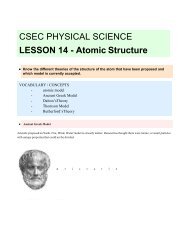Chapter 5 Maintaining Balance in Organisms
Chapter 5 Maintaining Balance in Organisms
Chapter 5 Maintaining Balance in Organisms
- No tags were found...
Create successful ePaper yourself
Turn your PDF publications into a flip-book with our unique Google optimized e-Paper software.
Part 3
The body has mechanisms to detect change and<strong>in</strong>itiate responses to br<strong>in</strong>g conditions back tonormal range Ex: how does the body make sure that just theright amount of vasopress<strong>in</strong> is released? Not toomuch or too little?Feedback Systems ma<strong>in</strong>ta<strong>in</strong> <strong>in</strong>ternal balance andregulate responses
Shuts off theresponse Ex:◦ body sensesdehydration◦ Produces and releasesvasopress<strong>in</strong>◦ Body senses watervolume <strong>in</strong> the body isback to normal◦ This stimulates thehypothalamus to stopproduc<strong>in</strong>g andreleas<strong>in</strong>ghypothalamus
Ex:◦ Low blood pressure is detected by walls of the arteries◦ Sends signal through nervous system and to the bra<strong>in</strong>◦ Bra<strong>in</strong>s send signal to the heart to pump faster and to theblood vessels to constrict◦ Increase <strong>in</strong> heart rate and artery diameter will <strong>in</strong>creaseblood pressureWhen blood pressure becomes too high, signal is sent tothe bra<strong>in</strong> and the body responds by relax<strong>in</strong>g bloodvessels and pump<strong>in</strong>g blood more slowly
Adjusts <strong>in</strong>ternalconditions toward the<strong>in</strong>itial condition Ex:◦ bleed<strong>in</strong>g causes a clott<strong>in</strong>gresponse◦ Clott<strong>in</strong>g fibers attractmore clott<strong>in</strong>g fibers(platelets) until bleed<strong>in</strong>gstopsChange detectedResponseMechanismsCont<strong>in</strong>ue untilInitial conditionsreturnCorrectiveMechanismsActivated
1. Nervous System – rapid, short term, very specificresponsesRegulates <strong>in</strong>voluntary physiological activities as wellas enabl<strong>in</strong>g the body to respond voluntarily tosensations2. Endocr<strong>in</strong>e System – slow, long term responsesComb<strong>in</strong>ation of fast and slow responses,automatic and voluntary, physiological andbehavioral are all important to ma<strong>in</strong>ta<strong>in</strong><strong>in</strong>ghomeostasis
What is a feedback system and what is itsfunction? A negative feedback system turns on or off aresponse? What is a positive feedback system? Give anexample of a positive feedback system <strong>in</strong> thebody. What are the differences between types ofresponses <strong>in</strong> the endocr<strong>in</strong>e system vs the nervoussystem?
All cells <strong>in</strong> the body needoxygen to function Carbon dioxide is a byproductof energymetabolism The respiratory system isthe ma<strong>in</strong> organ system<strong>in</strong>volved <strong>in</strong> gas exchangebut there are a number ofother systems thatcooperate with therespiratory system forproper function<strong>in</strong>g
Ma<strong>in</strong> organs◦ LungsFollow the air –1. Mouth or nose – air iswarmed, moistened, cleaned2. Larynx – mucous and cilia3. Trachea – mucous and cilia4. Bronchi (plural) Bronchus(s<strong>in</strong>gular) – mucous and cilia5. Bronchioles – mucous andcilia6. Alveolar Sac (s<strong>in</strong>gular),Alveoli (plural)
When oxygen reaches thesmallest compartment (alveoli),it can diffuse across the th<strong>in</strong> cellwalls (alveolar membranes) These small compartments havea surface area that is 40 timesgreater than the outer surface ofthe body◦ Allows for greater amount of oxygenthat can move <strong>in</strong>to the body, and agreater amount of carbon dioxidethat can move out of the body
The concentration of carbondioxide <strong>in</strong> the blood and <strong>in</strong>the air <strong>in</strong>side the alveolideterm<strong>in</strong>es the direction ofdiffusion If the concentration ofcarbon dioxide is higher <strong>in</strong>the blood than <strong>in</strong> the air onthe <strong>in</strong>side of the alveoli, thenthe carbon dioxide willdiffuse down theconcentration gradient
<strong>Ma<strong>in</strong>ta<strong>in</strong><strong>in</strong>g</strong> levels of carbon dioxide and oxygen<strong>in</strong>volves a precise feedback system andcoord<strong>in</strong>ation between◦ Respiratory system◦ Circulatory system◦ Nervous system
When your body is work<strong>in</strong>g harder, it produces more carbondioxideCarbon dioxide causes the blood to be more acidicNerve cells detect this acidity and send a signal to the bra<strong>in</strong>The bra<strong>in</strong> sends a signal to the respiratory system to contractthe diaphragm more frequently caus<strong>in</strong>g a faster breath<strong>in</strong>g rateFaster BR <strong>in</strong>creases oxygen levels <strong>in</strong> the blood
When exercise stops, carbon dioxide is produced at aslower rate Blood becomes less acidic Less acidity is detected by sensory receptors <strong>in</strong> theblood vessels Signal is sent to the bra<strong>in</strong> Bra<strong>in</strong> sends signal to diaphragm to contract moreslowly
What is carbon dioxide a product of <strong>in</strong> the body? What are the ma<strong>in</strong> structures (start<strong>in</strong>g at the mouthand end<strong>in</strong>g at the alveoli) that air we <strong>in</strong>hale passes by? What is the structural feature of the alveoli that allowsfor greater gas exchange <strong>in</strong> the lungs? Expla<strong>in</strong> the process of diffusion <strong>in</strong> the alveoli. Whatareas are greater concentrations for O2 and CO2? What is the relationship between feedback systemsand regulat<strong>in</strong>g levels of CO2 and O2 <strong>in</strong> the body? Expla<strong>in</strong> what happens <strong>in</strong> the body dur<strong>in</strong>g rapidexercise.
Draw a diagram of the respiratory system label<strong>in</strong>gkey features. Enlarge an area around an alveoli tohighlight gas exchange processes


